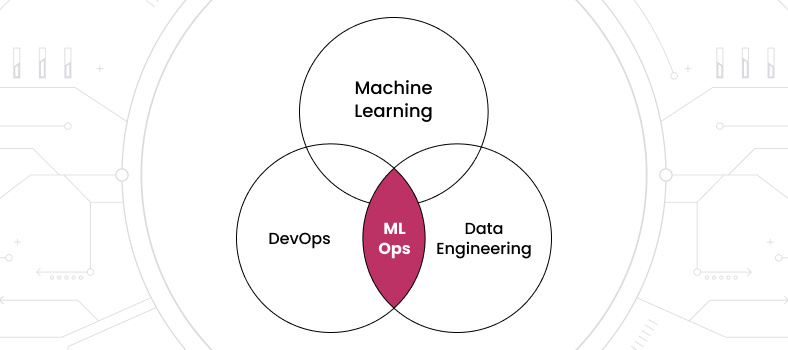While creating your machine learning model you might notice that the process is very complicated. Terabytes upon terabytes of convoluted data, constant maintenance, random bugs – the list goes on.
But it doesn’t have to be this hard. In recent years, the ML industry developed a set of principles that make the development process much easier and faster.
By combining the best practices of traditional software development and machine learning model development, Machine Learning Operations (MLOps) practices were born. Today, we want to discuss what they are and how they can be beneficial based on real-world MLOps examples.
Understanding MLOps
MLOps is a principle behind maintaining and deploying models in the machine learning niche. The improvements it brings to the ML workflow and its lifecycle management are widely praised for high efficiency and reliability.

There are four key principles in MLOps:
- Version Control: By tracking changes in your ML model, you can reproduce the results of experiments or roll back to previous versions in case a faulty version goes into the production environment;
- Automation: MLOps offers automation of tedious processes and the data pipeline to free your data scientists from constant maintenance of your ML model;
- Continuity: MLOps allows for continuous integration, delivery, and monitoring of your trained models;
- Model Governance: MLOps manages all aspects of ML systems for improved efficiency.
Thanks to MLOps, you can work on multiple models at once, giving your team the ability to expand the scope of their data science projects.
Furthermore, MLOps connects data science and operations, integrating AI and ML capabilities into real-world applications. This complexity and diversity positively influence market growth.
According to Business Research, the MLOps market size was 1.1 billion USD in 2022 and will reach 9 billion USD by 2029.
Forecasts like this are based on the demand surge that started during COVID and the latest trends in the MLOps market, such as cloud-based platforms and services.
The main driving factors for market growth are the following:
- Increase in complexity of machine learning models;
- Diversity of ML models;
- Rising need for collaboration and alignment among stakeholders.
ML model deployment involves various stakeholders and requires more sophisticated management methods and tools. MLOps is here to address these requirements.
It enables organizations to standardize their ML workflows across different teams and projects. It also provides a common platform and language for stakeholders. So, we’re pretty sure you can expect to see more analogs of MLOps pop up in different fields of AI models’ development.
The Role of MLOps in Overseeing the Machine Learning Process
You might think MLOps is just a trendy principle that doesn’t improve your workflow. But in reality, it is very beneficial and will make the machine learning process more robust and efficient.

Before we move on to MLOps use cases, let’s have a look at business benefits.
- Streamlining ML development. MLOps consulting provides a field for experimentation. It ensures reproducibility and version control in data pipelines, which makes any experiment results easy to recreate.
- Improved collaboration and workflow. Just like in traditional software development, collaboration and streamlined workflows are keys to success. To promote both, the MLOps platform brings standardization and automation to the table. This makes communication between departments more productive and automates tedious processes that obstruct an ideal workflow.
- Scalability and deployment. MLOps provides an easy way to scale ML models by enabling quick iterations and updates.
- Monitoring and maintenance. Monitoring is pivotal when you want to gather insights on machine learning models. The sooner you start monitoring the development process, the more valuable insights you’ll gather. This is why MLOps provides solutions to monitor model performance.
- Governance and compliance. Every company has its image to maintain. So, it’s understandable when the company wants its ML model to comply with industry standards. MLOps provides mechanisms for tracking and auditing model behavior, which helps ensure regulatory compliance.
- Cost efficiency and resource management. When it comes to machine learning model deployment, a lot of resources are trapped in constant maintenance. To combat this, MLOps provides ways to optimize resource usage and automates a lot of processes, for example, model management. This way, developers and data scientists have more space for experimentation without the risk of the model suddenly breaking down.
- Risk Mitigation: When developing your ML model, you should be ready for the risks that come with the process. For example, model drift, and biased or inaccurate models. Luckily, the MLOps platforms have robust testing and data quality assurance features.
To summarize, the role of MLOps in the AI development process cannot be overstated. It is a great tool that will help you make development faster and more streamlined, on top of saving money.
Now let’s cover some of the MLOps use cases in real life.
8 MLOps Examples that Drastically Change the Game for Businesses
As you can see from the benefits, MLOPs have a lot of potential to offer to any business. But are there any MLOps use cases that work in real life? We have gathered examples of successful companies that chose MLOps implementation for their workflows.
Starbucks as a Data-Driven Company
Starbucks launched its mobile app in 2011 intending to create a digital-based loyalty program. However, it was quickly expanded to have information about menus, store locations, and opening hours.
Soon enough, Starbucks realized that having an app could give them a significant competitive advantage. All they needed to do was analyze data to maximize customer lifetime value.
The development of such a sizable project might seem like a head-over-heel idea. The sheer amount of data processing couldn’t be operated on without an easy and quick way to scale an ML model. Luckily for Starbucks, MLOps practices provide just that.

Source
In 2019, they introduced a new AI-driven platform based on MLOps practices named “Deep Brew”. The main goal behind this initiative was to “elevate every aspect of the business and the in-store and customer experience”, as described by Starbucks’ chief technology officer Gerri Martin-Flickinger.
Deep Brew is a platform that allows personalizing the customer experience and optimizing store human resources allocation and inventory management.
Deep Brew has proven to be a huge success for Starbucks. This platform helped the brand to make business decisions that resulted in significant growth. Since its launch in 2019, Starbucks’ net revenue grew to almost 36.8 billion USD with an 11.46% increase each year.
The standard set by Starbucks with this MLOps example pushed the industry to evolve and switch to becoming data-driven to stay competitive.
I’m Lovin’ It: McDonald’s and Machine McLearning Operations
Another great MLOps example is McDonald’s. Since its initial opening in 1940, McDonald’s has grown into the world’s second-largest restaurant company by revenue. The brand has drastically changed over the years, adding more and more innovations. One such innovation was the concept of a drive-thru.
Drive-thru was so successful that in America, approximately 70% of all purchases were made from cars. This figure made McDonald’s look into ways of making this innovation as efficient and convenient as possible.

Source
In 2018, the company added a machine learning solution based on MLOps practices to drive-thrus at select locations. This solution considers purchases made by other customers when updating the offers presented on ordering displays. Soon enough, they expanded the functionality and now it covers the experience not only at the drive-thrus but inside their stores as well. Use of the MLOps examples can be found here:
- Store demand and forecasting;
- Product recommendations;
- Drive-thru automation;
- Customer lifetime value;
- Sentiment analysis of product reviews.
After the initial tests, McDonald’s decided to roll out this MLOps solution to more US and international locations in 2019. Now McDonald’s aims to scale this technology further to improve the personalization of customer experience.
How Walmart Changed its Resource Management
Walmart is one of the biggest retail corporations in America. As of the start of 2024, Walmart has over 10 thousand stores and clubs in 24 countries. You can imagine how hard it is to manage the resources of a corporation that has so many locations. So, how do they do it?
Walmart utilizes machine learning operations to enhance the efficiency and scalability of its machine-learning models. It provides Walmart with the ability to make data-driven decisions. This has a positive outcome on operational efficiency and customer satisfaction.
Benefits of MLOps: Realizing the Advantages of Automated ML Operations
Read more
Netflix and Real-Time Model Monitoring
Netflix has provided streaming services since 2007. As its user base increased, alongside did the catalog of movies and TV shows. The recommendation feature was born in the process, which was enhanced with AI soon enough. However, the number of viewers and offered content has continued to increase, requiring more efforts from AI engineers and data scientists.
It was decided to utilize real-time model monitoring to ensure recommendation quality using MLOps. Its practices help detect whether the user played a recommended video and compare the data to the predicted outcome. If there are any discrepancies in performance metrics, the system alerts the machine learning team to investigate and fine-tune the model.
Data Management at Ocado
According to statistics, the online share represents 26.5% of retail sales in the UK, and approximately 10% of all online retail sales come from Ocado.
Ocado is an online supermarket. And like any other online store, it deals with millions of events that happen every minute. This creates a need for a system that will adapt to new information and act accordingly. More specifically, they need a system that allows managing vast amounts of data. But how does it provide an MLOps example?

Source
Ocado applies an MLOps solution to data management and governance to achieve a streamlined process. This allows them to maintain data consistency, establish data governance frameworks, and improve overall data reliability.
Another example of Ocado’s utilization of MLOps is its microservice culture. By allowing them to trace events in the system, they can address anomalies and maintain reliable data throughout machine learning systems.
Lush Product Classification
For the next MLOps example, we have Lush.
Lush is a British cosmetic retailer that specializes in soaps, creams, shampoos, and other cosmetics for the face and hair. Recently, the company decided to expand its eco-friendly activities and become packaging-free.
To do that, Lush developed a mobile app feature that allows customers to view product information by taking a picture. This completely eliminates the need for packaging and labels, however, it requires a lot of data, which led the brand to MLOps implementation.
They developed an end-to-end, fully automated model training and serving pipeline for their ML model. This allows the company to retrain ML models when new product images are introduced. It also monitors model performance based on key metrics.
Revolut Against Card Fraud Detection
Revolut is a UK-based financial technology company that provides an online banking system. To strengthen their app security, the company adopted machine learning.
The system is called “Sherlock” and was developed with machine learning operations. The main goal behind this solution was to minimize the fraud losses caused by incorrectly blocked transactions.

Source
MLOps allowed the structuring of the data based on features it had, such as time of day, merchant’s name, how quickly the user made a transaction, etc. It also allowed Revoult to scale the machine learning model to handle millions of users and transactions.
Moreover, Revolut used MLOps to ensure the resilience and reliability of the service. Now it’s mostly used to provide core function performance since the feature has already been deployed.
Spotify Recommends Machine Learning
Ever wondered how Spotify recommendations know you so well? The answer is simple – they use a machine learning model to find the best-fitting music for your mood.
At the initial introduction of this feature in 2011, recommendations were lacking at best, although they already used machine learning. But thankfully, after countless iterations, they adopted MLOps practices.

The first iteration quickly hit the wall when their engineers spent more time maintaining the data rather than iterating on the model itself. This is because prior to MLOps adoption, they didn’t have standardized data and couldn’t bridge the gap between data, the machine learning model, and the backend.
In their second iteration, Spotify implemented some of the MLOps features, such as standardized data format, which allowed engineers to better understand the data during model deployment and development. However, this iteration still needed fixing, as it was hard to keep track of all independent machine-learning experiments.
The third iteration came to fix that. They decided to adopt MLOps fully, by implementing end-to-end ML models’ workflow. It gave an easy and quick version control solution while also handling resource and workload management.
This is what you need to know about AI trends that shape 2024
Read more
After launch, MLOps allowed for even more feature engineering experimentation for Spotify developers. By providing the team with new useful insights, the engineering team could focus on designing new machine learning models instead of maintaining their own infrastructure. This resulted in faster time from prototyping to production.
Conclusion
Machine learning operations are a great paradigm that helps optimize and improve AI/ML development services. It allows you to deploy models much faster and in a more optimized manner. With the surge in demand, brought by successful MLOps examples, the MLOps market is set to expand further.
A lot of companies started to implement MLOps-based solutions in their workflow. And it’s not surprising, knowing the level of automation and monitoring it brings. In this article, we have covered a couple of MLOps use cases and the benefits they bring to market-leading companies.
Building an MLOps solution for your business might sound hard for your team, but you can always count on us. We at CHI Software are experts in creating AI solutions for businesses with a vast range of cases you can check on our website. Contact us today, and we will reach out to you in a short timeframe.
About the author
Alex is a Data Scientist & ML Engineer with an NLP specialization. He is passionate about AI-related technologies, fond of science, and participated in many international scientific conferences.
Rate this article
24 ratings, average: 4.5 out of 5









